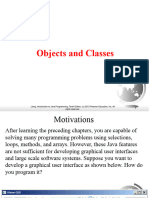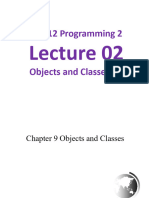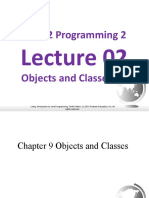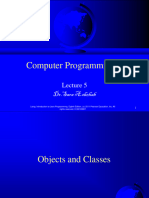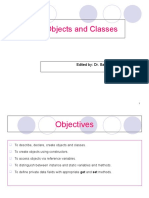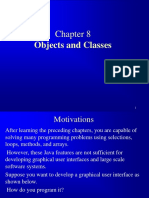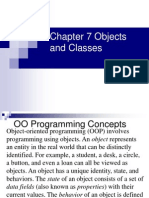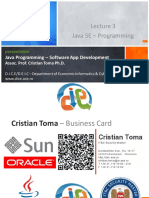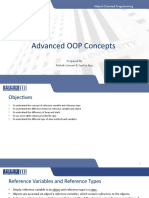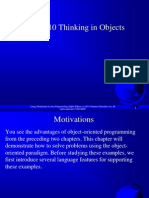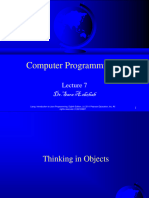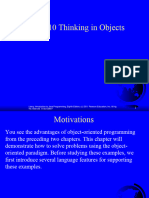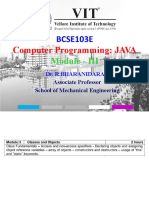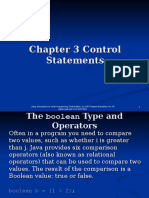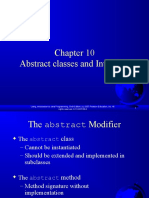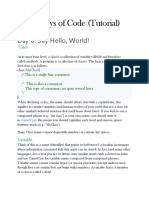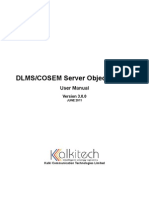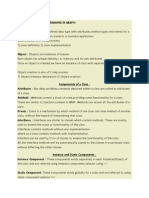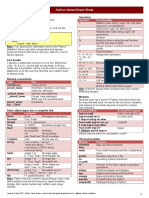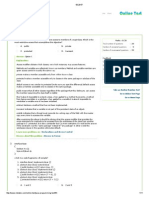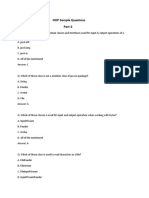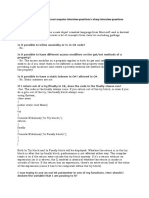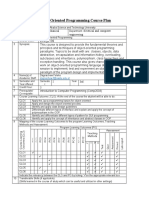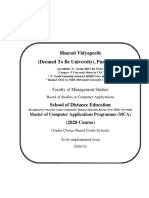OO Programming Concepts
Object-oriented programming (OOP) involves
programming using objects. An object represents
an entity in the real world that can be distinctly
identified. For example, a student, a desk, a circle,
a button, and even a loan can all be viewed as
objects. An object has a unique identity, state, and
behaviors. The state of an object consists of a set of
data fields (also known as properties) with their
current values. The behavior of an object is defined
by a set of methods.
Liang, Introduction to Java Programming, Sixth Edition, (c) 2007 Pearson Education, Inc. All rig
hts reserved. 0-13-222158-6
Objects
Class Name: Circle
A class template
Data Fields:
radius is _______
Methods:
getArea
Circle Object 1
Circle Object 2
Circle Object 3
Data Fields:
radius is 10
Data Fields:
radius is 25
Data Fields:
radius is 125
Three objects of
the Circle class
An object has both a state and behavior. The state
defines the object, and the behavior defines what
the object does.
Liang, Introduction to Java Programming, Sixth Edition, (c) 2007 Pearson Education, Inc. All rig
hts reserved. 0-13-222158-6
Classes
Classes are constructs that define objects of the
same type. A Java class uses variables to define
data fields and methods to define behaviors.
Additionally, a class provides a special type of
methods, known as constructors, which are
invoked to construct objects from the class.
Liang, Introduction to Java Programming, Sixth Edition, (c) 2007 Pearson Education, Inc. All rig
hts reserved. 0-13-222158-6
Classes
class Circle {
/** The radius of this circle */
double radius = 1.0;
/** Construct a circle object */
Circle() {
}
Data field
Constructors
/** Construct a circle object */
Circle(double newRadius) {
radius = newRadius;
}
/** Return the area of this circle */
double getArea() {
return radius * radius * 3.14159;
}
Method
Liang, Introduction to Java Programming, Sixth Edition, (c) 2007 Pearson Education, Inc. All rig
hts reserved. 0-13-222158-6
UML Class Diagram
Circle
UML Class Diagram
Class name
radius: double
Data fields
Circle()
Constructors and
Methods
Circle(newRadius: double)
getArea(): double
circle1: Circle
radius: 10
circle2: Circle
radius: 25
circle3: Circle
UML notation
for objects
radius: 125
Liang, Introduction to Java Programming, Sixth Edition, (c) 2007 Pearson Education, Inc. All rig
hts reserved. 0-13-222158-6
Constructors
Circle() {
}
Constructors are a special
kind of methods that are
invoked to construct objects.
Circle(double newRadius) {
radius = newRadius;
}
Liang, Introduction to Java Programming, Sixth Edition, (c) 2007 Pearson Education, Inc. All rig
hts reserved. 0-13-222158-6
Constructors, cont.
A constructor with no parameters is referred to as a
no-arg constructor.
Constructors must have the same name as the
class itself.
Constructors do not have a return typenot
even void.
Constructors are invoked using the new
operator when an object is created. Constructors
play the role of initializing objects.
Liang, Introduction to Java Programming, Sixth Edition, (c) 2007 Pearson Education, Inc. All rig
hts reserved. 0-13-222158-6
Creating Objects Using
Constructors
new ClassName();
Example:
new Circle();
new Circle(5.0);
Liang, Introduction to Java Programming, Sixth Edition, (c) 2007 Pearson Education, Inc. All rig
hts reserved. 0-13-222158-6
Default Constructor
A class may be declared without constructors. In
this case, a no-arg constructor with an empty body
is implicitly declared in the class. This constructor,
called a default constructor, is provided
automatically only if no constructors are explicitly
declared in the class.
Liang, Introduction to Java Programming, Sixth Edition, (c) 2007 Pearson Education, Inc. All rig
hts reserved. 0-13-222158-6
Declaring Object Reference Variables
To reference an object, assign the object to a reference
variable.
To declare a reference variable, use the syntax:
ClassName objectRefVar;
Example:
Circle myCircle;
Liang, Introduction to Java Programming, Sixth Edition, (c) 2007 Pearson Education, Inc. All rig
hts reserved. 0-13-222158-6
10
Declaring/Creating Objects
in a Single Step
ClassName objectRefVar = new ClassName();
Example:
Assign object reference
Create an object
Circle myCircle = new Circle();
Liang, Introduction to Java Programming, Sixth Edition, (c) 2007 Pearson Education, Inc. All rig
hts reserved. 0-13-222158-6
11
Accessing Objects
Referencing the objects data:
objectRefVar.data
e.g., myCircle.radius
Invoking the objects method:
objectRefVar.methodName(arguments)
e.g., myCircle.getArea()
Liang, Introduction to Java Programming, Sixth Edition, (c) 2007 Pearson Education, Inc. All rig
hts reserved. 0-13-222158-6
12
A Simple Circle Class
Objective:
Demonstrate creating objects,
accessing data, and using methods.
TestCircle1
Liang, Introduction to Java Programming, Sixth Edition, (c) 2007 Pearson Education, Inc. All rig
hts reserved. 0-13-222158-6
13
animation
Trace Code
Declare myCircle
Circle myCircle = new Circle(5.0);
myCircle
no value
SCircle yourCircle = new Circle();
yourCircle.radius = 100;
Liang, Introduction to Java Programming, Sixth Edition, (c) 2007 Pearson Education, Inc. All rig
hts reserved. 0-13-222158-6
14
animation
Trace Code, cont.
Circle myCircle = new Circle(5.0);
myCircle
no value
Circle yourCircle = new Circle();
: Circle
yourCircle.radius = 100;
radius: 5.0
Create a circle
Liang, Introduction to Java Programming, Sixth Edition, (c) 2007 Pearson Education, Inc. All rig
hts reserved. 0-13-222158-6
15
animation
Trace Code, cont.
Circle myCircle = new Circle(5.0);
myCircle reference value
Circle yourCircle = new Circle();
yourCircle.radius = 100;
Assign object
reference to myCircle
: Circle
radius: 5.0
Liang, Introduction to Java Programming, Sixth Edition, (c) 2007 Pearson Education, Inc. All rig
hts reserved. 0-13-222158-6
16
animation
Trace Code, cont.
Circle myCircle = new Circle(5.0);
myCircle reference value
Circle yourCircle = new Circle();
yourCircle.radius = 100;
: Circle
radius: 5.0
yourCircle
no value
Declare yourCircle
Liang, Introduction to Java Programming, Sixth Edition, (c) 2007 Pearson Education, Inc. All rig
hts reserved. 0-13-222158-6
17
animation
Trace Code, cont.
Circle myCircle = new Circle(5.0);
myCircle reference value
Circle yourCircle = new Circle();
: Circle
yourCircle.radius = 100;
radius: 5.0
no value
yourCircle
: Circle
Create a new
Circle object
radius: 0.0
Liang, Introduction to Java Programming, Sixth Edition, (c) 2007 Pearson Education, Inc. All rig
hts reserved. 0-13-222158-6
18
animation
Trace Code, cont.
Circle myCircle = new Circle(5.0);
myCircle reference value
Circle yourCircle = new Circle();
: Circle
yourCircle.radius = 100;
radius: 5.0
yourCircle reference value
Assign object
reference to yourCircle
: Circle
radius: 1.0
Liang, Introduction to Java Programming, Sixth Edition, (c) 2007 Pearson Education, Inc. All rig
hts reserved. 0-13-222158-6
19
animation
Trace Code, cont.
Circle myCircle = new Circle(5.0);
myCircle reference value
Circle yourCircle = new Circle();
: Circle
yourCircle.radius = 100;
radius: 5.0
yourCircle reference value
: Circle
Change radius in
yourCircle
radius: 100.0
Liang, Introduction to Java Programming, Sixth Edition, (c) 2007 Pearson Education, Inc. All rig
hts reserved. 0-13-222158-6
20
Caution
Recall that you use
Math.methodName(arguments) (e.g., Math.pow(3, 2.5))
to invoke a method in the Math class. Can you invoke getArea() using
Circle1.getArea()? The answer is no. All the methods used before this
chapter are static methods, which are defined using the static keyword.
However, getArea() is non-static. It must be invoked from an object
using
objectRefVar.methodName(arguments) (e.g., myCircle.getArea()).
More explanations will be given in Section 7.7, Static Variables,
Constants, and Methods.
Liang, Introduction to Java Programming, Sixth Edition, (c) 2007 Pearson Education, Inc. All rig
hts reserved. 0-13-222158-6
21
Reference Data Fields
The data fields can be of reference types. For example,
the following Student class contains a data field name of
the String type.
public class Student {
String name; // name has default value null
int age; // age has default value 0
boolean isScienceMajor; // isScienceMajor has default value false
char gender; // c has default value '\u0000'
}
Liang, Introduction to Java Programming, Sixth Edition, (c) 2007 Pearson Education, Inc. All rig
hts reserved. 0-13-222158-6
22
The null Value
If a data field of a reference type does not
reference any object, the data field holds a
special literal value, null.
Liang, Introduction to Java Programming, Sixth Edition, (c) 2007 Pearson Education, Inc. All rig
hts reserved. 0-13-222158-6
23
Default Value for a Data Field
The default value of a data field is null for a reference
type, 0 for a numeric type, false for a boolean type,
and '\u0000' for a char type. However, Java assigns
no default value to a local variable inside a method.
public class Test {
public static void main(String[] args) {
Student student = new Student();
System.out.println("name? " + student.name);
System.out.println("age? " + student.age);
System.out.println("isScienceMajor? " + student.isScienceMajor);
System.out.println("gender? " + student.gender);
}
}
Liang, Introduction to Java Programming, Sixth Edition, (c) 2007 Pearson Education, Inc. All rig
hts reserved. 0-13-222158-6
24
Example
Java assigns no default value to a local variable inside a method.
public class Test {
public static void main(String[] args) {
int x; // x has no default value
String y; // y has no default value
System.out.println("x is " + x);
System.out.println("y is " + y);
}
}
Compilation error: variables not
initialized
Liang, Introduction to Java Programming, Sixth Edition, (c) 2007 Pearson Education, Inc. All rig
hts reserved. 0-13-222158-6
25
Differences between Variables of
Primitive Data Types and Object Types
Created using new Circle()
Primitive type
int i = 1
Object type
Circle c
reference
c: Circle
radius = 1
Liang, Introduction to Java Programming, Sixth Edition, (c) 2007 Pearson Education, Inc. All rig
hts reserved. 0-13-222158-6
26
Copying Variables of Primitive
Data Types and Object Types
Primitive type assignment i = j
Before:
After:
2
Object type assignment c1 = c2
Before:
After:
c1
c1
c2
c2
c1: Circle
C2: Circle
c1: Circle
C2: Circle
radius = 5
radius = 9
radius = 5
radius = 9
Liang, Introduction to Java Programming, Sixth Edition, (c) 2007 Pearson Education, Inc. All rig
hts reserved. 0-13-222158-6
27
Garbage Collection
As shown in the previous figure, after the
assignment statement c1 = c2, c1 points to
the same object referenced by c2. The
object previously referenced by c1 is no
longer referenced. This object is known as
garbage. Garbage is automatically
collected by JVM.
Liang, Introduction to Java Programming, Sixth Edition, (c) 2007 Pearson Education, Inc. All rig
hts reserved. 0-13-222158-6
28
Garbage Collection, cont
TIP: If you know that an object is no
longer needed, you can explicitly assign
null to a reference variable for the
object. The JVM will automatically
collect the space if the object is not
referenced by any variable.
Liang, Introduction to Java Programming, Sixth Edition, (c) 2007 Pearson Education, Inc. All rig
hts reserved. 0-13-222158-6
29
The Date Class
Java provides a system-independent encapsulation of date
and time in the java.util.Date class. You can use the Date
class to create an instance for the current date and time and
use its toString method to return the date and time as a string.
The + sign indicates
public modifer
java.util.Date
+Date()
Constructs a Date object for the current time.
+Date(elapseTime: long)
Constructs a Date object for a given time in
milliseconds elapsed since January 1, 1970, GMT.
+toString(): String
Returns a string representing the date and time.
+getTime(): long
Returns the number of milliseconds since January 1,
1970, GMT.
+setTime(elapseTime: long): void
Sets a new elapse time in the object.
Liang, Introduction to Java Programming, Sixth Edition, (c) 2007 Pearson Education, Inc. All rig
hts reserved. 0-13-222158-6
30
The Date Class Example
For example, the following code
java.util.Date date = new java.util.Date();
System.out.println(date.toString());
displays a string likeSun Mar 09 13:50:19
EST 2003.
Liang, Introduction to Java Programming, Sixth Edition, (c) 2007 Pearson Education, Inc. All rig
hts reserved. 0-13-222158-6
31
The Random Class
You have used Math.random() to obtain a random double
value between 0.0 and 1.0 (excluding 1.0). A more useful
random number generator is provided in the java.util.Random
class.
java.util.Random
+Random()
Constructs a Random object with the current time as its seed.
+Random(seed: long)
Constructs a Random object with a specified seed.
+nextInt(): int
Returns a random int value.
+nextInt(n: int): int
Returns a random int value between 0 and n (exclusive).
+nextLong(): long
Returns a random long value.
+nextDouble(): double
Returns a random double value between 0.0 and 1.0 (exclusive).
+nextFloat(): float
Returns a random float value between 0.0F and 1.0F (exclusive).
+nextBoolean(): boolean
Returns a random boolean value.
Liang, Introduction to Java Programming, Sixth Edition, (c) 2007 Pearson Education, Inc. All rig
hts reserved. 0-13-222158-6
32
The Random Class Example
If two Random objects have the same seed, they will generate
identical sequences of numbers. For example, the following code
creates two Random objects with the same seed 3.
Random random1 = new Random(3);
System.out.print("From random1: ");
for (int i = 0; i < 10; i++)
System.out.print(random1.nextInt(1000) + " ");
Random random2 = new Random(3);
System.out.print("\nFrom random2: ");
for (int i = 0; i < 10; i++)
System.out.print(random2.nextInt(1000) + " ");
From random1: 734 660 210 581 128 202 549 564 459 961
From random2: 734 660 210 581 128 202 549 564 459 961
Liang, Introduction to Java Programming, Sixth Edition, (c) 2007 Pearson Education, Inc. All rig
hts reserved. 0-13-222158-6
33
Instance
Variables, and Methods
Instance variables belong to a specific instance.
Instance methods are invoked by an instance of
the class.
Liang, Introduction to Java Programming, Sixth Edition, (c) 2007 Pearson Education, Inc. All rig
hts reserved. 0-13-222158-6
34
Static Variables, Constants,
and Methods
Static variables are shared by all the instances of the
class.
Static methods are not tied to a specific object.
Static constants are final variables shared by all the
instances of the class.
Liang, Introduction to Java Programming, Sixth Edition, (c) 2007 Pearson Education, Inc. All rig
hts reserved. 0-13-222158-6
35
Static Variables, Constants,
and Methods, cont.
To declare static variables, constants, and methods,
use the static modifier.
Liang, Introduction to Java Programming, Sixth Edition, (c) 2007 Pearson Education, Inc. All rig
hts reserved. 0-13-222158-6
36
Static Variables, Constants,
and Methods, cont.
instantiate
circle1
radius = 1
numberOfObjects = 2
Circle
radius: double
numberOfObjects: int
getNumberOfObjects(): int
+getArea(): double
UML Notation:
underline: static variables or methods
instantiate
Memory
1
radius
numberOfObjects
radius
circle2
radius = 5
numberOfObjects = 2
Liang, Introduction to Java Programming, Sixth Edition, (c) 2007 Pearson Education, Inc. All rig
hts reserved. 0-13-222158-6
37
Example of
Using Instance and Class Variables
and Method
Objective: Demonstrate the roles of
instance and class variables and their
uses. This example adds a class variable
numberOfObjects to track the number of
Circle objects created.
Circle2
TestCircle2
Liang, Introduction to Java Programming, Sixth Edition, (c) 2007 Pearson Education, Inc. All rig
hts reserved. 0-13-222158-6
38
Visibility Modifiers and
Accessor/Mutator Methods
By default, the class, variable, or method can be
accessed by any class in the same package.
public
The class, data, or method is visible to any class in any
package.
private
The data or methods can be accessed only by the declaring
class.
The get and set methods are used to read and modify private
properties.
Liang, Introduction to Java Programming, Sixth Edition, (c) 2007 Pearson Education, Inc. All rig
hts reserved. 0-13-222158-6
39
package p1;
package p2;
public class C1 {
public int x;
int y;
private int z;
public void m1() {
}
void m2() {
}
private void m3() {
}
public class C2 {
void aMethod() {
C1 o = new C1();
can access o.x;
can access o.y;
cannot access o.z;
can invoke o.m1();
can invoke o.m2();
cannot invoke o.m3();
package p1;
class C1 {
...
}
public class C3 {
void aMethod() {
C1 o = new C1();
can access o.x;
cannot access o.y;
cannot access o.z;
can invoke o.m1();
cannot invoke o.m2();
cannot invoke o.m3();
}
package p2;
public class C2 {
can access C1
}
public class C3 {
cannot access C1;
can access C2;
}
The private modifier restricts access to within a class, the default
modifier restricts access to within a package, and the public
modifier enables unrestricted access.
Liang, Introduction to Java Programming, Sixth Edition, (c) 2007 Pearson Education, Inc. All rig
hts reserved. 0-13-222158-6
40
NOTE
An object cannot access its private members, as shown in (b).
It is OK, however, if the object is declared in its own class, as
shown in (a).
public class Foo {
private boolean x;
public static void main(String[] args) {
Foo foo = new Foo();
System.out.println(foo.x);
System.out.println(foo.convert());
}
public class Test {
public static void main(String[] args) {
Foo foo = new Foo();
System.out.println(foo.x);
System.out.println(foo.convert(foo.x));
}
}
private int convert(boolean b) {
return x ? 1 : -1;
}
}
(a) This is OK because object foo is used inside the Foo class
(b) This is wrong because x and convert are private in Foo.
Liang, Introduction to Java Programming, Sixth Edition, (c) 2007 Pearson Education, Inc. All rig
hts reserved. 0-13-222158-6
41
Why Data Fields Should Be
private?
To protect data.
To make class easy to maintain.
Liang, Introduction to Java Programming, Sixth Edition, (c) 2007 Pearson Education, Inc. All rig
hts reserved. 0-13-222158-6
42
Example of
Data Field Encapsulation
The - sign indicates
private modifier
Circle
-radius: double
The radius of this circle (default: 1.0).
-numberOfObjects: int
The number of circle objects created.
+Circle()
Constructs a default circle object.
+Circle(radius: double)
Constructs a circle object with the specified radius.
+getRadius(): double
Returns the radius of this circle.
+setRadius(radius: double): void
Sets a new radius for this circle.
+getNumberOfObject(): int
Returns the number of circle objects created.
+getArea(): double
Returns the area of this circle.
Circle3
TestCircle3
Liang, Introduction to Java Programming, Sixth Edition, (c) 2007 Pearson Education, Inc. All rig
hts reserved. 0-13-222158-6
43
Immutable Objects and Classes
If the contents of an object cannot be changed once the object
is created, the object is called an immutable object and its class
is called an immutable class. If you delete the set method in
the Circle class in the preceding example, the class would be
immutable because radius is private and cannot be changed
without a set method.
A class with all private data fields and without mutators is not
necessarily immutable. For example, the following class
Student has all private data fields and no mutators, but it is
mutable.
Liang, Introduction to Java Programming, Sixth Edition, (c) 2007 Pearson Education, Inc. All rig
hts reserved. 0-13-222158-6
44
Example
public class Student {
private int id;
private BirthDate birthDate;
public class BirthDate {
private int year;
private int month;
private int day;
public Student(int ssn,
int year, int month, int day) {
id = ssn;
birthDate = new BirthDate(year, month, day);
}
public BirthDate(int newYear,
int newMonth, int newDay) {
year = newYear;
month = newMonth;
day = newDay;
}
public int getId() {
return id;
}
public BirthDate getBirthDate() {
return birthDate;
}
}
public void setYear(int newYear) {
year = newYear;
}
}
public class Test {
public static void main(String[] args) {
Student student = new Student(111223333, 1970, 5, 3);
BirthDate date = student.getBirthDate();
date.setYear(2010); // Now the student birth year is changed!
}
}
Liang, Introduction to Java Programming, Sixth Edition, (c) 2007 Pearson Education, Inc. All rig
hts reserved. 0-13-222158-6
45
What Class is Immutable?
For a class to be immutable, it must mark all data fields private
and provide no mutator methods and no accessor methods that
would return a reference to a mutable data field object.
Liang, Introduction to Java Programming, Sixth Edition, (c) 2007 Pearson Education, Inc. All rig
hts reserved. 0-13-222158-6
46
Passing Objects to Methods
Passing by value for primitive type value
(the value is passed to the parameter)
Passing by value for reference type value
(the value is the reference to the object)
TestPassObject
Liang, Introduction to Java Programming, Sixth Edition, (c) 2007 Pearson Education, Inc. All rig
hts reserved. 0-13-222158-6
47
Passing Objects to Methods, cont.
Stack
Space required for the
printAreas method
int times: 5
Circle c: reference
Pass by value (here
the value is 5)
Pass by value
(here the value is
the reference for
the object)
Space required for the
main method
int n: 5
myCircle: reference
Liang, Introduction to Java Programming, Sixth Edition, (c) 2007 Pearson Education, Inc. All rig
hts reserved. 0-13-222158-6
Heap
A circle
object
48
Scope of Variables
The scope of instance and static variables is the
entire class. They can be declared anywhere inside
a class.
The scope of a local variable starts from its
declaration and continues to the end of the block
that contains the variable. A local variable must be
initialized explicitly before it can be used.
Liang, Introduction to Java Programming, Sixth Edition, (c) 2007 Pearson Education, Inc. All rig
hts reserved. 0-13-222158-6
49
The this Keyword
Use this to refer to the object that invokes
the instance method.
Use this to refer to an instance data field.
Use this to invoke an overloaded
constructor of the same class.
Liang, Introduction to Java Programming, Sixth Edition, (c) 2007 Pearson Education, Inc. All rig
hts reserved. 0-13-222158-6
50
Serving as Proxy to the Calling Object
class Foo {
int i = 5;
static double k = 0;
void setI(int i) {
this.i = i;
}
Suppose that f1 and f2 are two objects of Foo.
Invoking f1.setI(10) is to execute
f1.i = 10, where this is replaced by f1
Invoking f2.setI(45) is to execute
f2.i = 45, where this is replaced by f2
static void setK(double k) {
Foo.k = k;
}
Liang, Introduction to Java Programming, Sixth Edition, (c) 2007 Pearson Education, Inc. All rig
hts reserved. 0-13-222158-6
51
Calling Overloaded Constructor
public class Circle {
private double radius;
public Circle(double radius) {
this.radius = radius;
}
this must be explicitly used to reference the data
field radius of the object being constructed
public Circle() {
this(1.0);
}
this is used to invoke another constructor
public double getArea() {
return this.radius * this.radius * Math.PI;
}
Every instance variable belongs to an instance represented by this,
which is normally omitted
Liang, Introduction to Java Programming, Sixth Edition, (c) 2007 Pearson Education, Inc. All rig
hts reserved. 0-13-222158-6
52
Array of Objects
Circle[] circleArray = new Circle[10];
An array of objects is actually an array of
reference variables. So invoking
circleArray[1].getArea() involves two
levels of referencing as shown in the next
figure. circleArray references to the entire
array. circleArray[1] references to a
Circle object.
Liang, Introduction to Java Programming, Sixth Edition, (c) 2007 Pearson Education, Inc. All rig
hts reserved. 0-13-222158-6
53
Array of Objects, cont.
Circle[] circleArray = new Circle[10];
circleArray
reference
circleArray[0]
circleArray[1]
Circle object 0
Circle object 1
circleArray[9]
Circle object 9
Liang, Introduction to Java Programming, Sixth Edition, (c) 2007 Pearson Education, Inc. All rig
hts reserved. 0-13-222158-6
54
Array of Objects, cont.
Summarizing the areas of the circles
TotalArea
Liang, Introduction to Java Programming, Sixth Edition, (c) 2007 Pearson Education, Inc. All rig
hts reserved. 0-13-222158-6
55
Class Abstraction and Encapsulation
Class abstraction means to separate class implementation
from the use of the class. The creator of the class provides
a description of the class and let the user know how the
class can be used. The user of the class does not need to
know how the class is implemented. The detail of
implementation is encapsulated and hidden from the user.
Class implementation
is like a black box
hidden from the clients
Class
Class Contract
(Signatures of
public methods and
public constants)
Clients use the
class through the
contract of the class
Liang, Introduction to Java Programming, Sixth Edition, (c) 2007 Pearson Education, Inc. All rig
hts reserved. 0-13-222158-6
56

